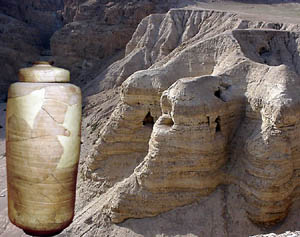
The initial discovery was by chance in 1947, and not by archaeologists! Bedouin shepherds found seven scrolls or parts of scrolls and fragments, along with store jars and broken pottery jars in a cave overlookingthe northwest end of the Dead Sea. When a dealer acting on behalf of the shepherds sold the scrolls, they came to the attention of scholars in Jerusalem and then the scholarly world.
Subsequent investigations in the area of the cave of discovery ultimately led to the recovery of documents in a total of eleven caves and the archaeology excavation of a modest ruin nearby known as Khirbet (the ruin of) Qumran. All of this was occurring as the modern State of Israel was coming into existence, with all the political upheaval involved in that development. As this century ends and a new one begins, efforts for a peaceful political settlement in the region continue and give signs of reaching fruition. In the meantime, scholars continue to study the multitude of fragments recovered and to attempt to assess their significance.
Among the more than eight hundred documents represented by whole scrolls, incomplete scrolls, and a myriad of fragments which have been recovered are complete copies or portions of all the books in the Hebrew Bible (our OT), except for the Book of Esther. These texts are older by at least a thousand years than any previous biblical texts written in Hebrew that we had prior to the discovery. They provide a window into the textual history of the OT prior to the closure of the canon.
Besides copies of scriptural texts, from the caves in the Qumran area came sectarian documents that open a panorama on the obscure Jewish group apparently related to the production and deposition of the manuscripts. This group was likely the Essenes, previously known from references to them in the writings of Flavius Josephus, Philo Judaeus, and Pliny the Elder. All the texts discovered, taken together, open a critical window into events in Palestine in the decades prior to and following the birth of Christ (although no NT texts were found among the scrolls) up to the time of the First Jewish Revolt against the Romans. The historical period of the Dead Sea Scrolls illuminates the environment in which Christianity developed in Palestine, the transformation of Judaism into Rabbinic Judaism in the aftermath of the First Revolt of the Jews against the Romans with the destruction of Jerusalem and its temple, and the context in which the canonization of Holy Scripture was progressing.
The Dead Sea Scrolls now reside mainly in the Shrine of the Book, a part of the Israel Museum in Jerusalem where they are on display. The Copper Scroll can be seen in the Archaeological Museum in Amman, Jordan. Many of the small fragments are housed in the Rockefeller Museum in East Jerusalem. Scholars work almost exclusively with photographs and microfilm of the fragments, however, and these are available to scholars at many of the major universities around the world. It is likely that researchers will still be at work on the scrolls fifty years hence.
For more interesting topics related to archaeology, visit archaeology excavations.
No comments:
Post a Comment